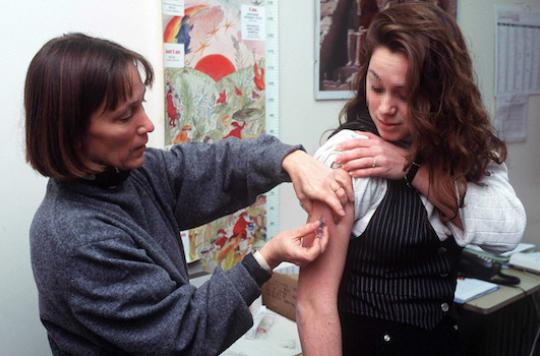Of the 500,000 French people with hepatitis B or C, half do not know. A lack of knowledge that the B virus is 100 times more contagious than HIV. However, the fight against these diseases scores points.

Some clearings on the forehead of hepatitis B and VS … And a first very good news: the rate of hepatitis B vaccine coverage which has long been in France one of the lowest in Europe for infants, has gone in infants aged 6 months, from 31% in 2007 to 81% in 2010, according to the latest figures from the French Institute for Public Health Surveillance (InVS). In addition, after unfounded rumors about the harmful effects of hepatitis B vaccination that marked the 1990s, a survey by the National Institute for Prevention and‘health education (INPES) reveals thate nine out of ten general practitioners are in favor of thevscination of adults at risk, and 78% for adolescents. VSthe data is importanyour because general practitioners have a central role in prevention: when mothers are not advised by their doctor, only one in two has their child vaccinated.
Another positive point, in recent years, treatments have evolved a lot. “Thanks to new mothecules, between 70 and 80% of hepatitis C are now cured, explains the professor Daniel Dhumeaux, Chairman of the Monitoring and Foresight Committee of the National Hepatitis B and C Control Program. And is about the‘hepatitis B, we can today the control in more than 80% of cases, without forgetting that there is an effective vaccination for prevention. The diagnosis has also been simplified. ” In case of’hepatitis C for example, with the development of so-called non-invasive tests, it is no longer necessary to take a liver biopsy to decide whether or not to treat the person ”.
A screening. But these reasons for satisfaction in the fight against hepatitis B and C should not mask the efforts to be made. Faced with these diseases, which can be very silent at first, too few people think of being screened. It is estimated that in mainland France, around 500,000 people are infected with B or C viruses, “300,000 for the‘viral infection B and 200,000 louser viral infection C , according to Professor Dhumeaux, but overall half of them are unaware of their infection, ie 250,000 people ”. “If we compare to infection with HIV, the number of patients with unscreened hepatitis is 5 times higher. “
Prof. Daniel Dhumeaux, chairman of the monitoring committee for the 2009-2012 national hepatitis plan: ” If we compare to HIV, the number of patients with unscreened hepatitis is 5 times higher. “
In addition, with the suspicion that surrounded vaccination against the hepatitis B virus, an entire generation skipped the vaccination box. TOnear the end of the campaign school vaccination in 1998, a large number of young people have not been vaccinated. Being now from young adults, they are in full swing in the age group at risk.
Not knowing the disease is dangerous for oneself but also for others. “Hepatitis viruses are more contagious than HIV,” recalls Dr. Pascal Mélin, President of SOS Hépatites. For example, hepatitis B infection is 100 times more contagious than HIV. »Small reminder: the two viruses, B and C, are transmitted by blood. This explains why in the past blood transfusion was the most frequent mode of transmission. Now that all donors are tested, the risk situations are first intravenous drug use – but also nasal – tattoos and piercings, nosocomial risk during an intervention. But the B virus can also be transmitted sexually and from mother to child during childbirth.
Another danger that favors the spread of these diseases is the lack of knowledge. The InVS investigated the knowledge of the French on the modes of transmission of hepatitis B and C viruses. the hepatitis B virus can be transmitted through unprotected sex. And one in five people mistakenly think that a mosquito bite can transmit it, a falsehood that is also found in the same proportion for HIV.
“In general, the results of this study do not surprise ment no, there is still too much confusion. We must review our perception of these liver diseases, believes the president of SOS Hepatitis. For example, in the minds of the French, cirrhosis equals alcohol consumption … But you should know that United States, the main cause of cirrhosis is no longer alcohol andt viruses, but obesity… ”The president of SOS Hépatites pleads for new information campaigns of the general public which feront update on hepatitis, but also on all the situations known to induce diseases foie, in order to change all risky behaviors for this vital organ.
Dr Pascal Mélin, the president of SOS Hépatites: ” It is clear that we have an intellectual representation of the liver as an organ which regenerates itself all the time and which never poses a health concern… We do not think so to the damage to which it may be the object, such as those induced by the hepatitis we are talking about today, by excessive alcohol consumption and, as has been previously recalled, by excess weight, situations for which there are effective prevention methods.“.
Dr Pascal Mélin also pleads for better information for doctors. “As with HIV with the Yéni report, health professionals must have access to official recommendations on the management of hepatitis. Good information is the key to changing behavior, and also to convincing people of the individual and collective interest of screening and vaccination. The Hepatitis Plan 2009-2012 has worked in this direction. “It has also set up an evaluation of rapid orientation and diagnostic tests (TROD) which allow to know quickly, just with saliva or a drop of blood taken from the fingertip, if you are a carrier of the virus or not. »Explains Professor Dhumeaux. Its results should be known within the year. A plus to broaden the scope of screening.
The current control plan ends at the end of 2012. Its assessment is underway by an independent body whose conclusions will be very useful in continuing to improve the management of these infections, which remain a major public health problem. Professor Dhumeaux recalls that “in Europe today, hepatitis C, because of its complications, is the first indication for liver transplantation”. There is no doubt that efforts in the fight against hepatitis should be continued.
Find out more
InVS
national plan against hepatitis 2009-2012
SOS Hepatitis
.















